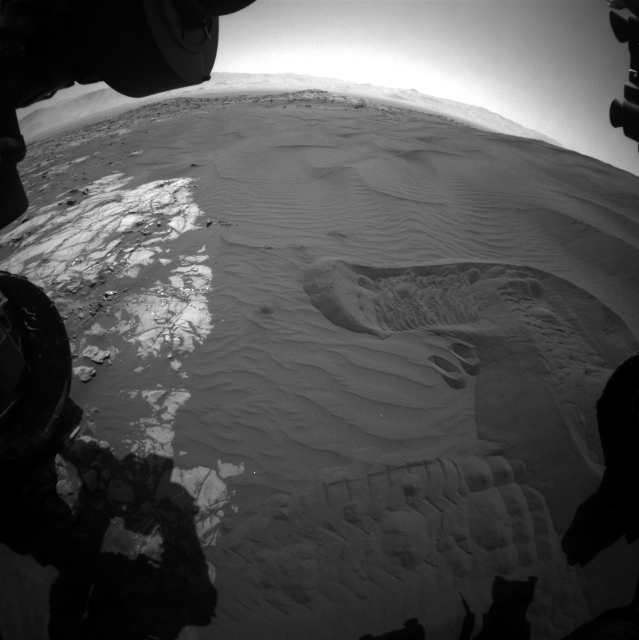Jan 22 2016
NASA's Mars Rover Curiosity is currently inspecting an active sand dune, using some sample-processing moves never before used on Mars.
 This view captures Curiosity's current work area where the rover continues its campaign to study an active sand dune on Mars. This site is part of the Bagnold Dunes, a band of dark sand dunes along the northwestern flank of Mars' Mount Sharp. Image Credit: NASA/JPL-Caltech
This view captures Curiosity's current work area where the rover continues its campaign to study an active sand dune on Mars. This site is part of the Bagnold Dunes, a band of dark sand dunes along the northwestern flank of Mars' Mount Sharp. Image Credit: NASA/JPL-Caltech
The second and third samples of sand scooped from "Namib Dune" will be categorized by grain size with two sieves. Making it's debut on Mars is the coarser sieve, which changes the way the treated sample is placed into an inlet port inside the rover.
It was a challenge to position the rover to collect a portion of the sand dune. Curiosity arrived at this sampling site, known as "Gobabeb," on January 12.
It was pretty challenging to drive into the sloping sand and then turn on the sand into the position that was the best to study the dunes.
Michael McHenry, NASA's Jet Propulsion Laboratory, Pasadena, California.
McHenry is the Curiosity mission's campaign rover planner for collection of these samples.
Since August 2012 when it landed on Mars, Curiosity has only collected material at one other site. It collected sand and dust at a windy drift site referred to as "Rocknest" in October and November 2012. Between there and Gobabeb, the Mars rover collected samples for analysis at nine rocky targets, by drilling instead of scooping.
The mission's present work is the first close-up analysis of active sand dunes at any location other than Earth. The "Bagnold Dune Field," consists of Namib and nearby mounds of dark sand, it lines the northwestern side of a covered mountain where Curiosity is analyzing rock records of very old environmental conditions. Study of the dunes has provided information on how wind moves and sorts sand particles in an environment with less atmosphere and gravity, compared to that on Earth.
Sand in dunes exists in varying grain compositions and sizes. Wind sorting can concentrate specific grain compositions and sizes, as composition is interlinked to density, based on when and where the wind has been active. The Gobabeb location was chosen to include newly formed ripples. Information about the aspects of the planet’s modern environment can aid the mission's analysis of composition, differences, and ripple patterns in very old sandstones that were formed from flowing water or wind.
On January 14th Curiosity scooped its first dune sample. The rover first scuffed the dune with a wheel.
The scuff helped give us confidence we have enough sand where we're scooping that the path of the scoop won't hit the ground under the sand.
Michael McHenry, NASA's Jet Propulsion Laboratory, Pasadena, California.
The first scoop was processed in a similar way the Rocknest samples were. Some complex moves of a device containing multiple chambers on the rover's arm transferred the material using a sieve, which screened out grains larger than 150 µm (0.006 inch); some of the material passing this finer sieve filled the laboratory inlet ports through a "portioner" on the device; material that was blocked was dumped onto the ground.
The portioner is located above an opened inlet port on the rover’s deck to drop a portion into it when the processing device vibrates and a release door is opened. Other than analyzing samples transported to its laboratory instruments, Curiosity can utilize other instruments to analyze sample material that are dumped onto the ground.
The second scoop of Gobabeb was collected by Curiosity on January 19th. This involved the coarser sieve, which allowed particles up to 1 mm (1,000 µm or 0.04 inch) to fall through.
Sand from this scoop was first fed to the finer 150-µm sieve. Material not passing through the 150-µm sieve was fed to the coarser 1 mm sieve. The fraction sent for laboratory analysis are sand grains that did not pass through the 150-µm sieve, but passed through the 1 mm sieve.
What you have left is predominantly grains that are smaller than 1 millimeter and larger than 150 microns. We start the vibration and gradually tilt the scoop. The material flows off the end of the scoop, in more of a stream than all at once.
John Michael Morookian, Rover Planning Team Lead for Curiosity
Curiosity reached the base of Mount Sharp 2014 after successfully investigating outcrops near its landing site, and then traveling to the mountain. On the lower part of the mountain, the mission is examining how Mars' ancient environment was transformed from the wet and favorable conditions suitable for microbial life to the present drier and harsher conditions.